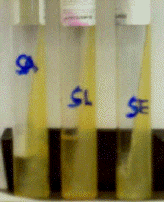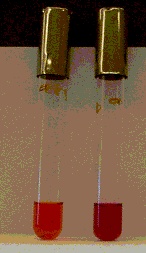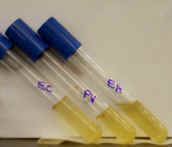
Laboratory Investigations in Microbiology

 |
Laboratory Investigations in Microbiology |
 |
Aside from purely metabolic reactions designed to obtain food, many bacteria produce extracellular enzymes for other functions related to survival in their environment:
Catalase test (Atlas p. 44) : For bacteria
living in oxygen-rich environs, the enzyme catalase is essential for
disposing of toxic hydrogen peroxide. Together with the enzyme superoxide
dismutase, catalase can dispose of oxygen free radicals. Bacteria that are
obligate aerobes (e.g. Micrococcus) or facultative anaerobes (e.g. Staphylococcus)
are almost always catalase-positive. Bacteria that are aerotolerant, such as Enterococcus
and Streptococcus, are usually found in anaerobic environments and lack
the enzyme catalase. Likewise. obligate anaerobes, such as Clostridium, do not
produce this enzyme. Catalase perform the following reaction:
: For bacteria
living in oxygen-rich environs, the enzyme catalase is essential for
disposing of toxic hydrogen peroxide. Together with the enzyme superoxide
dismutase, catalase can dispose of oxygen free radicals. Bacteria that are
obligate aerobes (e.g. Micrococcus) or facultative anaerobes (e.g. Staphylococcus)
are almost always catalase-positive. Bacteria that are aerotolerant, such as Enterococcus
and Streptococcus, are usually found in anaerobic environments and lack
the enzyme catalase. Likewise. obligate anaerobes, such as Clostridium, do not
produce this enzyme. Catalase perform the following reaction:
2H2O2 + catalase à 2H2O + O2
When hydrogen peroxide is added to a bacterial lawn or colony, bubbles of oxygen gas are given off. This bubbling indicates a positive catalase test.
Urease test (Atlas p. 81): Several bacteria strains have the ability to break down the nitrogen-containing compound urea. The products of urea hydrolysis are carbon dioxide and ammonium:
Urea + urease + H2O à CO2 + 2 NH3
The ammonia generated can benefit bacteria in two ways. First, ammonia is a
base, since it buffers free hydrogen ions (acid): 
NH3 + H+ à NH4+
Bacteria that live in acidic environments, such as the pathogen Helicobacter pylori (the cause of Peptic Ulcer Disease), use urease to buffer the acid around them, enabling them to survive and grow. Other bacteria use urease to obtain ammonia as a source of nitrogen. Ammonia is useful for the synthesis of amino acids and nucleotides from precursor molecules:
Pyruvate +NH3 à alanine
Urease activity is detected by culturing bacteria in a broth containing urea and a pH indicator. Hydrolysis of urea results in an increase in pH of the medium and a change in the medium's color to purple. This indicates a positive urease test. A negative urease test is observed when the color of the broth remains red/orange.
Gelatinase test (Atlas p. 54): When
collagen is boiled, gelatin is produced. Gelatin is a protein th at
solidifies at room temperature, but is liquid at 35C. Gelatin (collagen), of
course, is a major component of connective tissue in animals, forming a
defensive barrier between the outer layers of skin and the body's interior.
Pathogenic bacteria sometimes produce an enzyme to break down (hydrolyze) this
protein, allowing them to spread further in the body they infected. Like DNAse,
gelatinase is a virulence factor that makes the bacteria more harmful. We can
test for the presence of gelatinase by incubating bacteria in a gelatin deep.
During incubation, the gelatin melts, forming a liquid for bacterial growth. If
bacteria hydrolyze the gelatin, producing amino acids, the protein can no longer
gel when cooled down. A gelatin deep that remains liquid after cooling down
indicates a positive test for gelatinase (EA). If the deep hardens again
after cooling, the test is negative (EC, PV).
at
solidifies at room temperature, but is liquid at 35C. Gelatin (collagen), of
course, is a major component of connective tissue in animals, forming a
defensive barrier between the outer layers of skin and the body's interior.
Pathogenic bacteria sometimes produce an enzyme to break down (hydrolyze) this
protein, allowing them to spread further in the body they infected. Like DNAse,
gelatinase is a virulence factor that makes the bacteria more harmful. We can
test for the presence of gelatinase by incubating bacteria in a gelatin deep.
During incubation, the gelatin melts, forming a liquid for bacterial growth. If
bacteria hydrolyze the gelatin, producing amino acids, the protein can no longer
gel when cooled down. A gelatin deep that remains liquid after cooling down
indicates a positive test for gelatinase (EA). If the deep hardens again
after cooling, the test is negative (EC, PV).
Coagulase test (Atlas p. 46): Yet another enzyme that aids pathogenic bacteria is coagulase. Staphylococcus aureus is perhaps the best-known bacterium with this enzyme. Coagulase causes plasma to clot (coagulate). bacteria that are threatened by white blood cells can secrete this enzyme, producing a clot around themselves that the white blood cells cannot penetrate. This gives the bacteria time to multiply. We can test for this enzyme by inoculating a small volume of rabbit serum with bacteria. If a clot forms in the serum, the test is positive for coagulase. If the medium remains liquid, the test is negative.
Next lab period:
Next lab period:
Next lab period
Next lab period
© 2003 - 2019 José de Ondarza, Ph.D.